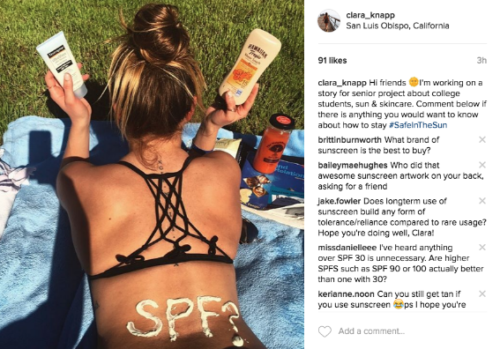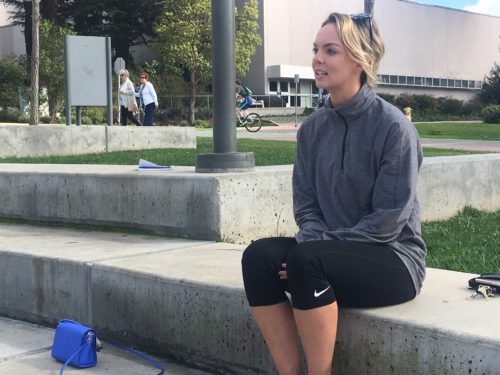
It has been raining more than usual lately in San Luis Obispo, so when a few days of sunshine finally came around, my senior project team was only thinking about one thing: tanning. It’s a favorite Cal Poly student pastime, and why shouldn’t it be? Cal Poly has an outdoorsy culture that encourages people to have a “healthy” tan, and spending time hanging out in the sunshine at the pool or beach with friends is easy at our campus.
But what about all the things people don’t like to think about when it comes to fun in the sun? Things like skin cancer, wrinkles, sun spots and aging. And, of course, putting on sunscreen. As college students, even though we know the risks of sun exposure, we think sunscreen makes tanning impossible, we forget to put it on… or we’re simply too lazy. Realizing that this could potentially have far-reaching effects on skin gave birth to the concept behind our story: discovering the true risks of sun exposure for people our age, and the effects it may have later on in life.
Getting Started
Our senior project team of four worked to bring all the pieces together: Maggie Hitchings working on the print version, Allison Royal covering multimedia, Barbara Levin featuring a Cal Poly student with skin cancer in a broadcast piece, and myself (Clara Knapp) coordinating the project in a PR role.
I thought this was a tough yet exciting topic to cover. It was a tough topic to cover because everyone knows that it’s bad to not wear sunscreen, but everyone ignores it. Finding a different and intriguing angle was the first challenge but once we gathered our sources we were able to tackle the topic. – Barbara Levin
Day one of the project, I posted on social media to get some opinions from the community on what exactly they would like to learn from a story on this topic. I posted on my personal Facebook page, a Cal Poly Facebook page and on Twitter, and was excited to receive feedback from a wide range of people, and even the Olay Skin company! I also posted on Instagram, and received helpful questions from students at Cal Poly – this was a great way to engage with potential readers.

These social media responses were able to give us some direction once we contacted our sources and had all the interviews lined up.
Finding the Facts
As a team, were able to talk to a wide range of people with knowledge about sun exposure, skin cancer and skincare. Our sources included a tanning salon employee, a microbiologist who does research on UVA and UVB rays, and a Cal Poly student who struggles with skin cancer.
Going into our story I was a little lost on what the angle was going to be. I was getting stressed out that our story wasn’t going to be interesting enough or informative past what people already know about sun protection. However, after attending the interviews I gained so much insight on both the scientific side, from Dr. Fidopiastis, and emotional side, from Monica, about skin cancer. The story really came together and I think it will be informative for students and hopefully scare some people into wearing sunscreen and protecting themselves! – Maggie Hitchings

Attending these interviews taught me things about sun and UV exposure that surprised me. Casey Handcock, a Cal Poly civil engineering major and tanning salon employee, told me that some of her clients have been prescribed tanning by doctors in order to treat spider veins, Vitamin D deficiency, and other skin conditions such as acne.

“My favorite part of the project was interviewing Casey. She explained tanning like donuts – if you have a donut here and there in moderation, you’re okay. If you have 20 donuts and eat them everyday, that’s unhealthy.”– Allison Royal
Gaining a New Perspective
People need to realize that it isn’t always “just a mole” and there really is no such thing as “a healthy tan.” The research shows that skin cancer is extremely common and can be devastating, even for people in college.
This topic was a reminder that there are lasting impacts to such decision and we were lucky enough to gather valuable sources such as Monica Roos who have a first-hand experience on the damages that the sun can do to you. I really learned about the consequences that just a few sunburns can do to you and think this will impact my decisions of being outside and protecting myself everyday. – Barbara Levin
